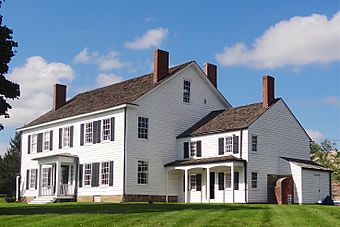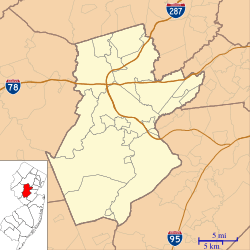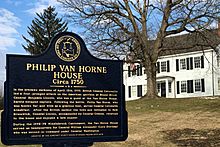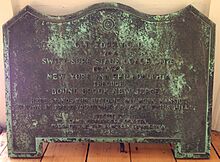Van Horne House facts for kids
|
Van Horne House
|
|

The Van Horne House in 2013
|
|
| Location | 941 East Main Street Bridgewater, New Jersey |
|---|---|
| Area | 2 acres (0.81 ha) |
| Built | c. 1750 |
| Architectural style | Colonial Revival |
| NRHP reference No. | 02000133 |
Quick facts for kids Significant dates |
|
| Added to NRHP | March 8, 2002 |
The Van Horne House is a historic home in Bridgewater Township, New Jersey. Built around 1750, this house played an important role in the American Revolutionary War. It was located on the Old York Road, a major route connecting Philadelphia and New York City.
The house was owned by Philip Van Horne, who nicknamed it Phil's Hill. During the war, it served as a headquarters for American generals like Benjamin Lincoln and William Alexander, Lord Stirling. Because of its history and unique architecture, the house was added to the National Register of Historic Places in 2002. Today, it is used by the Heritage Trail Association.
Contents
A House in the Middle of a War
The house was built around 1750 by Philip Van Horne (1719–1793). Before the Revolutionary War, he was a colonel in the local militia and a judge for Somerset County.
A Place for Friends and Enemies
Philip Van Horne was famous for his hospitality. He welcomed guests from both the American and British sides of the war. His home became known as Convivial Hall because it was always full of people and activity.
His friendly attitude toward both sides made some American leaders nervous. General George Washington once wrote that he was worried about Van Horne's loyalty:
I wish you had brought Vanhorne off with you, for from his noted Character, there is no dependance to be placed upon his Parole.
This means Washington thought Van Horne couldn't be trusted to keep his promises. Even though he was arrested at one point, he was allowed to stay at his home.
A famous story from the Battle of Bound Brook on April 13, 1777, shows his unique position. On that single day, he had breakfast with the British General Charles Cornwallis and later had supper with the American Generals Benjamin Lincoln and Nathanael Greene.
Headquarters for American Generals
During the winter of 1778–1779, the Continental Army set up its second Middlebrook encampment nearby. The Van Horne House became the headquarters for Major General William Alexander, Lord Stirling. He was in charge of the camp while General Washington was in Philadelphia. Other famous officers, like General Henry Lee III (also known as Light-Horse Harry), also stayed at the house.
The Simcoe Raid
On October 26, 1779, the house was part of a daring British raid. Lieutenant Colonel John Graves Simcoe and his Queen's Rangers came looking for important American leaders. They hoped to capture either the governor of New Jersey or an American colonel.
Simcoe and his soldiers searched the house but didn't find their main targets. After taking some prisoners, they continued their raid toward a nearby bridge.
From War House to Modern Times
In 1934, a company called the Calco Chemical Company bought the house. The company built a large factory on the land next to the house.
Starting in 1937, the company restored the house to look like it did in the colonial period. It was used as a guesthouse for important company visitors. During World War II, the house was even used as office space for the department that sold important medicines to the military.
Architecture and Location
The Van Horne House is a two-story building with a gable roof, which is a roof with two sloping sides that form a triangle. The stone foundation of the house is original from the 18th century.
The house was remodeled between 1937 and 1944 in a style called Colonial Revival. This style was popular in the 20th century and aimed to copy the look of buildings from America's colonial past. The house sits on a hill, giving it a good view of the area.
Gallery
-
Old York Road bronze tablet
-
A plan of the Battle of Bound Brook
See also
- Other houses used as headquarters during the second Middlebrook encampment (1778–79):
- Wallace House – General George Washington
- Van Veghten House – General Nathanael Greene
- Staats House – General Friedrich Wilhelm von Steuben
- Jacobus Vanderveer House – General Henry Knox








